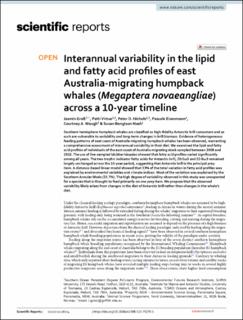| dc.contributor.author | Groß, Jasmin | |
| dc.contributor.author | Virtue, Patti | |
| dc.contributor.author | Nichols, Peter D. | |
| dc.contributor.author | Eisenmann, Pascale | |
| dc.contributor.author | Waugh, Courtney Alice | |
| dc.contributor.author | Bengtson Nash, Susan | |
| dc.date.accessioned | 2021-02-10T13:50:05Z | |
| dc.date.available | 2021-02-10T13:50:05Z | |
| dc.date.created | 2020-11-10T09:41:54Z | |
| dc.date.issued | 2020 | |
| dc.identifier.citation | Groβ, J., Virtue, P., Nichols, P. D., Eisenmann, P., Waugh, C. A. & Nash, S. B. (2020). Interannual variability in the lipid and fatty acid profiles of east Australia-migrating humpback whales (Megaptera novaeangliae) across a 10-year timeline. Scientific Reports Scientific Reports, 10: 18274. doi: | en_US |
| dc.identifier.issn | 2045-2322 | |
| dc.identifier.uri | https://hdl.handle.net/11250/2727232 | |
| dc.description.abstract | Southern hemisphere humpback whales are classified as high-fidelity Antarctic krill consumers and as such are vulnerable to variability and long-term changes in krill biomass. Evidence of heterogeneous feeding patterns of east coast of Australia migrating humpback whales has been observed, warranting a comprehensive assessment of interannual variability in their diet. We examined the lipid and fatty acid profiles of individuals of the east coast of Australia migrating stock sampled between 2008 and 2018. The use of live-sampled blubber biopsies showed that fatty acid profiles varied significantly among all years. The two trophic indicator fatty acids for Antarctic krill, 20:5ω3 and 22:6ω3 remained largely unchanged across the 10-year period, suggesting that Antarctic krill is the principal prey item. A distance-based linear model showed that 33% of the total variation in fatty acid profiles was explained by environmental variables and climate indices. Most of the variation was explained by the Southern Annular Mode (23.7%). The high degree of variability observed in this study was unexpected for a species that is thought to feed primarily on one prey item. We propose that the observed variability likely arises from changes in the diet of Antarctic krill rather than changes in the whale’s diet. | en_US |
| dc.language.iso | eng | en_US |
| dc.publisher | Nature | en_US |
| dc.rights | Navngivelse 4.0 Internasjonal | * |
| dc.rights.uri | http://creativecommons.org/licenses/by/4.0/deed.no | * |
| dc.title | Interannual variability in the lipid and fatty acid profiles of east Australia-migrating humpback whales (Megaptera novaeangliae) across a 10-year timeline | en_US |
| dc.type | Peer reviewed | en_US |
| dc.type | Journal article | en_US |
| dc.description.version | publishedVersion | en_US |
| dc.rights.holder | © 2020 The Author(s) | en_US |
| dc.subject.nsi | VDP::Matematikk og Naturvitenskap: 400 | en_US |
| dc.subject.nsi | VDP::Matematikk og Naturvitenskap: 400::Zoologiske og botaniske fag: 480::Marinbiologi: 497 | en_US |
| dc.source.pagenumber | 14 | en_US |
| dc.source.volume | 10 | en_US |
| dc.source.journal | Scientific Reports | en_US |
| dc.identifier.doi | 10.1038/s41598-020-75370-5 | |
| dc.identifier.cristin | 1846413 | |
| dc.source.articlenumber | 18274 | en_US |

